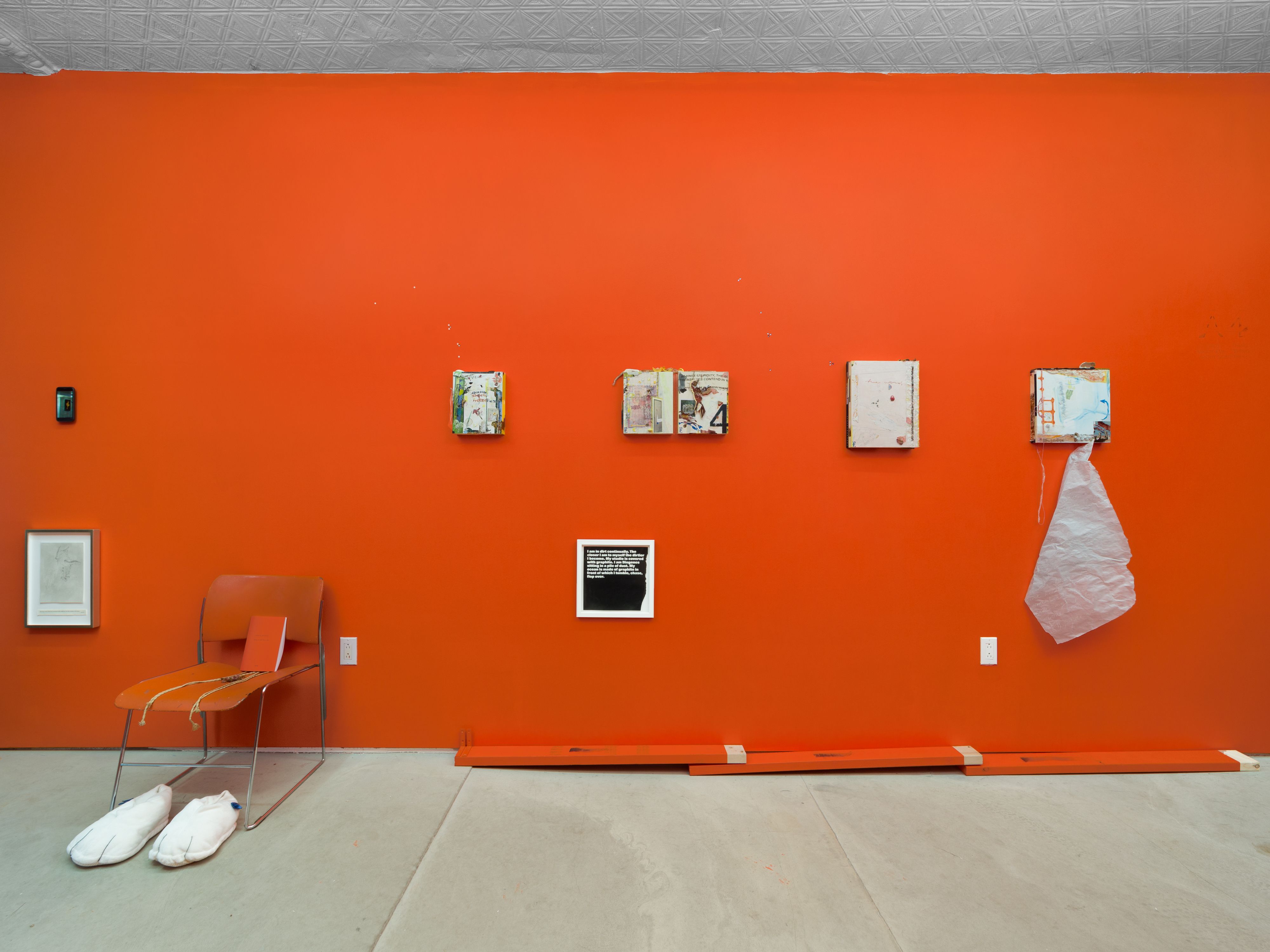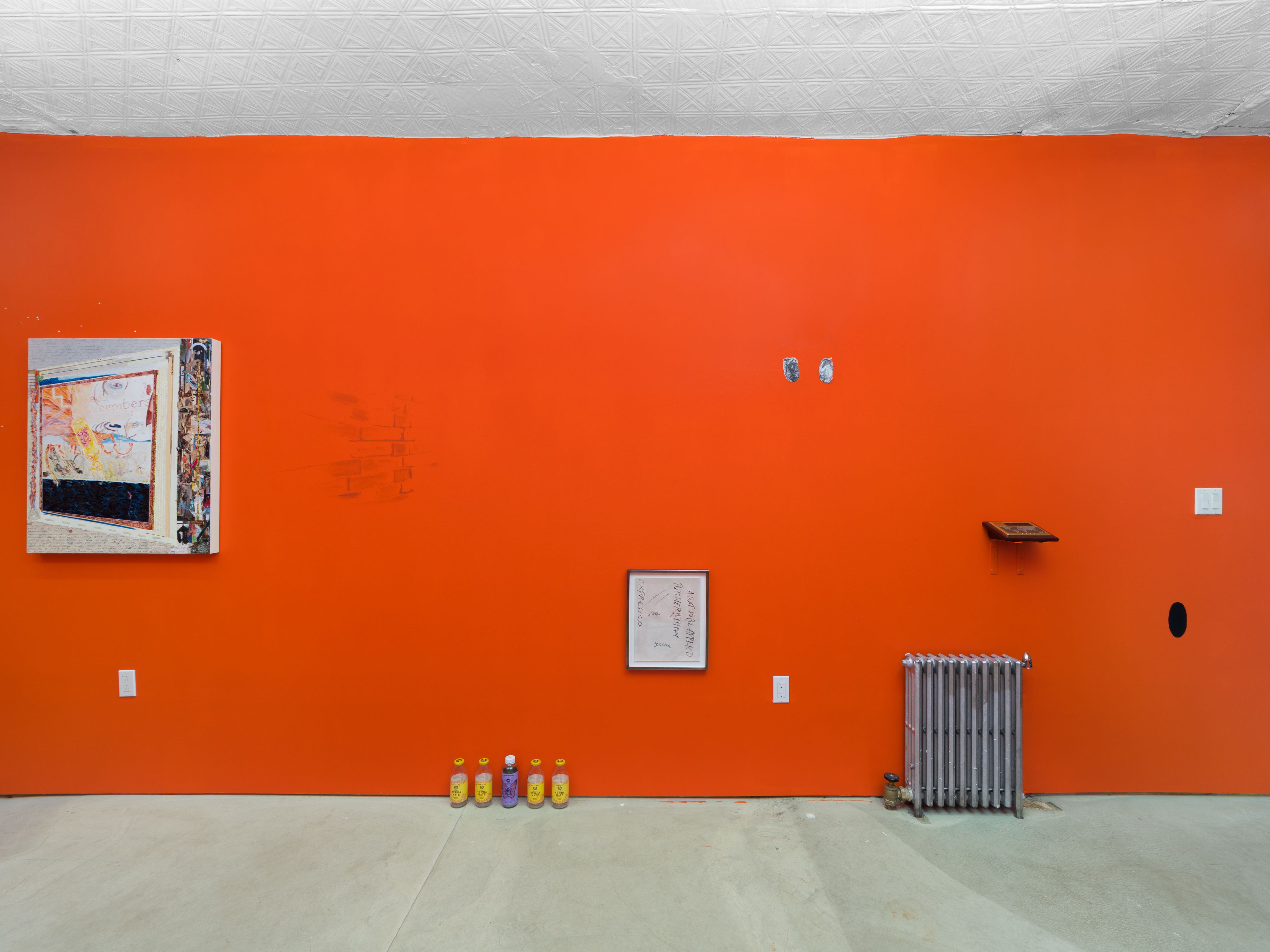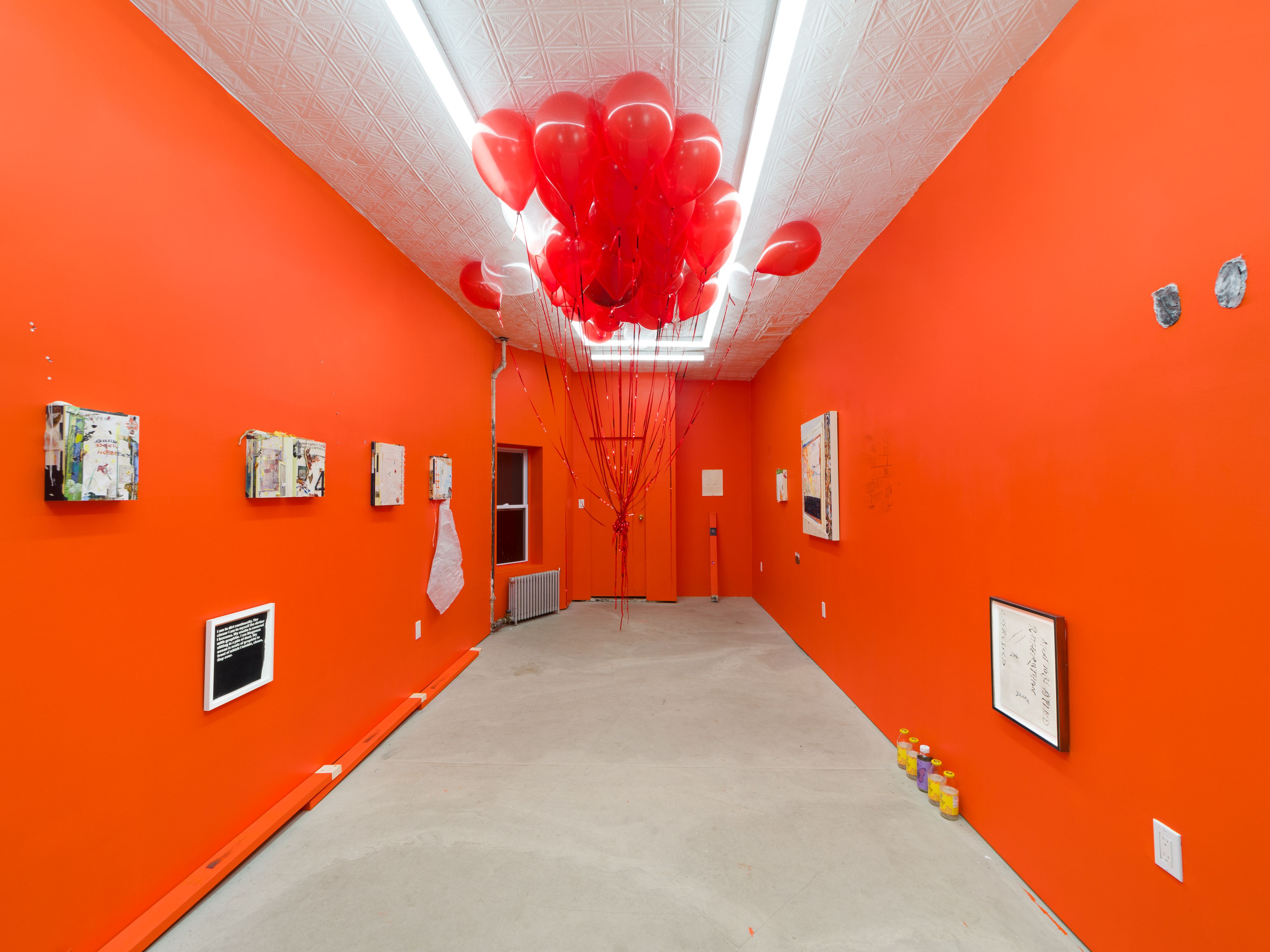Of Course, You Realize, This Means War
Paige K. B.
May 4th — June 4th, 2023
Opening May 5, 6:00 — 8:00 PM
Blade Study
17 Pike Street
New York, NY 10002
Press Release & Checklist

Paige K. B. is an artist and writer who works with painting, collage, and printing methods ranging from the traditional to the digital towards the fashioning of installations that treat authenticity, authorship, and the mythology of the artist like so many rocks to be turned over to expose other creatures, lovable or not, to the light. In this show she continues her exploration of character goods—the merchandising of fictional personae that accompanies a successful media property—into a new body of work that doesn’t so much recall her past ones as insist that, as in a body of water, it would be absurd to insist that one drop should be unique. Her dense, detail-oriented visual aesthetic is research-based and related to the established corpus of her published writing. Her practice darts between signifiers and genres while nodding greetings and salutations at the conventions of contemporary branding and medium specificity.
The centerpiece of this installation is an oil painting that compresses a range of material that could have become an essay into a visual composition where citations of images and texts—rendered by hand or printed out and worked into shape, some plebeian and some sophisticated, a few with contradictory political connotations— lose some of their unique information. This parallels what happens to a digital file for the purposes of circulation and ease of use. In a handmade artwork, a poor image becomes richly rendered once more through preservation and rebuilding, but there’s loss anyway. In gathering so much together, something has to give.
Six smaller paintings and collages on panels serve as that work’s “footnotes,” though their explicative function is here turned into more of a generative complication—like feedback. A few spoonfuls of distortion help the content go down. And if not, we’ll just gun it and have a Sugar Daddy candy bar anyway. Though hardly a dog whistle, the ideological wrapper of choice here is actually that of a book—its spine, netting, signatures, and covers of fine Prussian blue cloth. The paintings are studded with “comments” inline, including further exhibits below and all around, appended like wax seals or a tenderly yellow Post-It. Illuminating, like those old manuscripts, or just yellowed, like a faded note never heeded. Pense-Bête—do you remember? Please, he said, take my poetry—throw me a bone over here! Oh M. B., you were so sincere.
Some works here are signed with a single blue initial: P. This is self-promotion at minimum efficiency. The hubris smarts—only a real Prince could get away with that sort of singularity! Devoid of subject matter, the autograph is quaintly generic—just another letter from the alphabet, or a self in a world of selves competing for recognition. Many could identify with this character. Or, as the poet Arthur Rimbaud wrote in a letter to his teacher in May 1871: “I is someone else.”
You may notice that it would be fair enough to say that this is a show of paintings. One could run with that story, just as many painters today seem to prefer retreading the plains of illusionistic space as if the past 70 years never happened. Listen, you can call Paige many things, but never ahistorical. Her works breed in a barnacled, fluid environment, sweet and acid like juices of certain fruits, open for business like wounds to be operated on. As Corita Kent said in her 1966 essay “Doors Are Like Letters Are Like Love,” these works exist “somewhere in between singing and silent reading, somewhere in between Gutenberg and the image industries.” The commercialism of today’s culture assigns value based on likeness to known quantities, ergo the artist uses techniques and signifiers of ye olde original means of mass reproduction, publishing—that is, transcription and editing of texts into layouts, the ISO-approved standard A4 paper size. Her artworks often rope in documentation of her output, resulting in an off-serial process that constellates toward the elsewhere that’s been dragged back into the house like some old dug-up bones placed expectantly at our feet. Thank you my boy, but don’t stare at me with those ground-up ZERO pigment eyes like black holes. Walk away instead, like a best friend.
The author of that essay with the famous Angel, Walter Benjamin articulated a materialist presentation of history, wherein “to write history, therefore means to quote history. But the concept of quotation implies that any given historical object must be ripped out of its context.” The rip, the tear, and the re-placement speak in a contemporary sense to the endless mutability demanded of artists in an economy where attention is king. Here’s the picture one way–don’t like it? Here it is again, same but different, like a two-way street, back and forth, now and then. The beat changes / same instrument. Turn out the lights and we’ll find yet another array of pictures glowing in the dark—this one goes out to all you Romantics out there. I can’t see them now, but it still feels like the cherry blossoms are fluttering down on my dethroned ass anyway. So play “I” in one person, many people.
I’m seeing a vertiginous vermilion all around this room—perhaps it’s 2012? Seems plausible, since it’s all over, as they keep saying. We’ve been through this before though—now the statement looks different, but the content is the same. Who would you be to tell me otherwise? Noli me tanger-ine! I was hoping to be seen by the fire but I might settle for a spell in a chair instead—my slippers are there at the foot, awaiting the feet I’ll be voting with. I’m jumping back a few thousand years now, but just to put this on the table: No more secrets, Anubis—that’s what you tried to say, sitting on a tomb just as a dog might. “We Need Decembers,” as Corita said in another essay, at least to have gotten to this point from which all will spring. ’Tis the season. It’s true. Or, true enough. And now, the eagle has flown—that’s all folks! Congratulations!
— Paige K. Bradley
Paige K. B. is an artist and writer from Los Angeles based in New York. She studied at the California Institute of the Arts, the National College of Art & Design in Dublin, Ireland, and the Rhode Island School of Design, where she received a BFA in Printmaking. She has staged solo exhibitions at KAJE and Lubov and has been included in group exhibitions at Theta, Kai Matsumiya, and the Broodthaers Society of America, in addition to contributing to Canal Street Research Association’s installation for the most recent iteration of “Greater New York” at MoMA PS1. Her work has appeared in the New Yorker and Artforum, and her writing has been featured in numerous publications and online platforms for the past decade including Artforum, Frieze, Viscose, GARAGE, Topical Cream, and Spike. She authored the monograph Suellen Rocca: In Dreams, The Last Works (Matthew Marks, 2022) and has a new essay in a forthcoming catalogue from the Swiss Institute. A long-form article on text-based artworks by Jay Chung and Q Takeki Maeda, Vanessa Place, and Jack Goldstein will be co-published in French by the FRAC Lorraine (France) and mfc-michele didier (Belgium), as well as in an English edition by SIG-Verlag (Germany). In the past year, she has been included in readings at the Drawing Center, organized by art historian and critic Alex Kitnick, and at Artists Space, as part of the prestigious Segue reading series for poetry organized by curators Jay Sanders and Stella Cilman. The artist will also take part in a group show at Simone Subal opening near the end of May.
Translation provided by DeepL
Paige K. B. is an artist and writer from Los Angeles based in New York. She has staged solo exhibitions at Blade Study, KAJE, and Lubov and been included in thematic and group exhibitions at Somerset House in London as well as Simone Subal, Kai Matsumiya, the Broodthaers Society of America, and Theta in New York, in addition to contributing to Canal Street Research Association’s installation for the 2021–22 iteration of “Greater New York” at MoMA PS1. Her work has been featured numerous times on Contemporary Art Daily and written about in The New Yorker, Cultured, e-flux Criticism, and Artforum, among other publications, and her own writing has been featured in numerous magazines, catalogues, and online platforms for over a decade including The New York Review of Books, Artforum—where she was formerly an associate editor—Texte zur Kunst, Frieze, Viscose, GARAGE, Topical Cream, Triple Canopy, and Spike. She authored the monograph Suellen Rocca: In Dreams, The Last Works (Matthew Marks, 2022) and her second book, Drive It All Over Me, was published by S*I*G-Verlag in Berlin and released at Maxwell Graham in New York in October 2023. She has participated in readings at Artists Space, the Drawing Center, McNally Jackson, and on Montez Press Radio.

INSTALLATION

WORKS

Paige K. B.
you’re finally awake! it’s morning, 2022
36" x 31" x 2"Latex paint, oil, acrylic, graphite, charcoal, water soluble colored pencil, watercolor, Urban Decay “ZERO” pigment, preserved cherry blossom, eggshell, gampi paper, flashe paint, enamel paint, ink-jet prints on paper, handmade abaca paper, oil-based woodcut print on handmade abaca paper, oil pastel, wax, hand-marbled mulberry paper, glassine, rock, PVA, collage, book super, and book-cloth on wood panel


Paige K. B.
Footnotes (Build Back better yet again), 2023
10" x 8" x 2"Latex paint, watercolor ground, acrylic, gouache, ink-jet prints on paper, graphite, oil pastel, oil-based ink, oil-based woodcut print on handmade abaca paper, wax, eggshells, preserved cherry blossoms, unpreserved flower petals, seashell, volcanic ash rock, silk organza, thread, PVA, bookbinding net, and book cloth on hardboard panel


Paige K. B.
Footnotes (NO STEP, not unlike “I don’t speak dog...”), 2023
10" x 8" x 2"Latex paint, watercolor ground, acrylic, gouache, ink-jet prints on paper, graphite, oil pastel, ink, wax, pencil, unpreserved cherry blossom, candy, seashell, dyed eggshells, preserved cherry blossom, egg tempera, PVA, bookbinding net, and book cloth on birch wood panel


Paige K. B.
Footnotes (AGAINST STUPIDITY THE GODS THEMSELVES CONTEND IN VAIN...SOME CAUSE HAPPINESS...), 2023
10" x 8" x 2"Latex paint, watercolor ground, acrylic, gouache, ink-jet prints on paper, wax, dye sublimation print on polyester voile, graphite, oil pastel, ink, wax, pencil, enamel paint on cardboard, cork, flashe paint, seashell, coral, dyed eggshell preserved cherry blossom, egg tempera, oil-based etching ink on tarlatan, gampi paper, PVA, bookbinding net, and book cloth on birch wood panel

Paige K. B.
Footnotes (the word,), 2023
14" x 11" x 2"Latex paint, watercolor ground, enamel paint, acrylic, gouache, ink-jet prints on paper, wax, dye sublimation print on polyester voile, graphite, hand-marbled mulberry paper, egg tempera, preserved cherry blossom, ink, wax, pencil, cork, coral, dyed eggshell, oil-based ink, oil-based woodcut print on handmade abaca paper, bubblewrap, bookbinding net, and book cloth with embroidery thread on hardboard panel


Paige K. B.
Footnotes (Whether Packed or Compressed; Window or Rug; Falling or Ascending—it’s a privilege to be a jester), 2023
12.25" x 12" x 1.5"Latex paint, oil, wax, gampi, embroidery on silk organza, oil- based woodcut print on handmade abaca paper, inkjet-prints on paper, acrylic, PVA, acrylic, cardboard, bookbinding net, book cloth, seashell, volcanic ash pebble, and cotton string on birch wood panel with water-soluble graphite and carbon pencil on gampi paper with wax

Paige K. B.
Footnotes (We Need Decembers, I’m sketching it out, this is my sword—weaker than the word), 2023
12.25" x 12" x 1.5"Latex paint, oil, ink-jet prints on paper, wax, acrylic, bookbinding net, book cloth, Urban Decay “ZERO” pigment, cardboard, gouache, dyed eggshell, and seashell on birch wood panel with water-soluble graphite on gampi paper

Paige K. B.
The Jump (after “The Jump”), 2022
Digital video loop on iPhone, seventeen seconds.

Paige K. B.
NO STEP, but cornered, so I take ownership of it—I turn tail and leave a memorable line in the wake, 2023
16" x 11"Acrylic, graphite, and ink-jet print on paper in silver leaf frame


Paige K. B.
Chair Does Not Care :D feat. "Drive It All Over Me," 2023
30" x 19" x 21"Single Rowland 40/4 chair with book snakes, artist’s book, preserved cherry blossoms, and pair of Di Gi Charat slippers

Paige K. B.
Scrapping for parts, leaving the rest in my dust (with compliments to Rosemarie Castoro), 2023
12.5" x 12.5"Framed magazine page

Paige K. B.
A4, 2023
Dimensions variableGraphite on wall

Paige K. B.
Three Out of Four Bars Agree, 2023
Dimensions variableLatex paint and graphite on birch wood with latex painted brackets and wax

Paige K. B.
Rose, 2023
7" x 7"Vinyl

Paige K. B.
What’s Good for Anubis Is Good for the Gander..., 2023
14" x 11"Unframed graphite and watercolor on rag paper


Paige K. B.
The Dissenting Opinion, 2023
4' x 2'Latex paint and graphite with Polaroid, wax, dried rose petal, bookbinding net, preserved cherry blossom, book cloth, paper, and PVA on birch wood

Paige K. B.
99 Red Balloons of Diplomacy, 2023
Dimensions variableThirty-one red balloons

Paige K. B.
7, 2023
Dimensions variableGraphite and acrylic on wall

Paige K. B.
Country Road, Take Me Home..., 2010
4" x 6"Unframed Kodak photographic print

Paige K. B.
...Found in The Room That Does Not Care—meanwhile my soul, or value, remains a moving target, 2023
Dimensions variableGraphite on wall

Paige K. B.
"The historical human is passionate. He or she desires recognition, desires the desire of the other.," 2023
Dimensions variableFive glass bottles

Paige K. B.
A Text To Be Applied..., 2022
17" x 14"Graphite, acrylic, and watercolor ground on rag paper

Paige K. B.
ZERO eyes, 2023
Dimensions variableGraphite, watercolor ground, and glassine with wax on wall

Paige K. B.
Face Value, 2023
6.5" x 8.5" x 2.75"Seiko world clock with latex painted brackets

Paige K. B.
That’s All, Folks, 2023
Dimensions variableEnamel paint on wall

Paige K. B.
There’s More (RIP), 2023
Dimensions variableAcrylic on glass

Events






